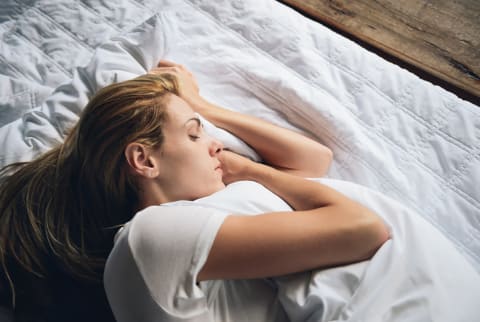Found: A Self-Hypnosis Hack To Fall Asleep Instantly (Swear!)


Self-hypnosis may sound like a suspicious concept, but according to David Spiegel, M.D., a Stanford psychiatrist and co-founder and chief scientific officer of Reveri, who's been studying hypnosis for over 40 years, it’s actually an incredibly powerful and therapeutic tool if you know how to use it.
On a recent episode of the mindbodygreen podcast, Spiegel shared one simple tip that everyone can try: a self-hypnosis strategy for better sleep. Below, find the how-to.
A self-hypnosis exercise to fall asleep
Some people fall asleep with ease, but I’d argue most people face difficulty with this feat at some point in time (if not frequently). Rather than scrolling on your phone or repeatedly looking at the clock to calculate how much sleep you’re losing, focus on comforting your body, Spiegel says.
"Imagine you're floating in a bath, a lake, a hot tub, or floating in space," he suggests. You also may want to practice what he calls a cyclic sigh, "where you inhale halfway, hold your breath, and fully and slowly exhale through your mouth," he explains. "As you do that, you trigger the soothing parasympathetic autonomic system and help your body relax."
Plus, focusing on your breath may inherently turn your attention away from worrisome thoughts. This takes some dedicated focus, but as many meditation and breathwork experts will tell you, it gets easier with time and repeated effort.
While you’re helping your body relax, acknowledge any negative or stressful thoughts that may bubble up. Rather than hyper-focusing on them and trying to come up with solutions, Spiegel recommends projecting these intrusive thoughts as if you were watching them on a screen.
"You may even think of something you can do to help with the problem, but you're experiencing your thoughts as if they were just flowing through you, not something you need to act on," Spiegel adds. "And that can help people get to sleep."
Feel free to utilize other sleep-enhancing tools to make this step easier, too.
Keep your room temperature between 65 and 72 degrees Fahrenheit or below (optimal sleeping temperature, research suggests), use a weighted blanket to ease anxious thoughts, and take a magnesium-based sleep supplement (some of our favorites, here).
The takeaway
If you struggle to fall asleep quickly, try Spiegel's easy self-hypnosis technique: Envision your body in a comfortable environment (a bath, swimming pool, floating space, etc.), practice mindful breathing, and view any intrusive thoughts as distant images on a screen, reminding yourself that now is not the time to resolve any problems. There are plenty more self-hypnosis tips in the episode; tune in below to learn more about this therapeutic tool.

Hannah Frye is the Assistant Beauty & Health Editor at mindbodygreen. She has a B.S. in journalism and a minor in women’s, gender, and queer studies from California Polytechnic State University, San Luis Obispo. Hannah has written across lifestyle sections including skin care, women’s health, mental health, sustainability, social media trends, and more. She previously interned for Almost 30, a top-rated health and wellness podcast. In her current role, Hannah reports on the latest beauty trends and innovations, women’s health research, brain health news, and plenty more.